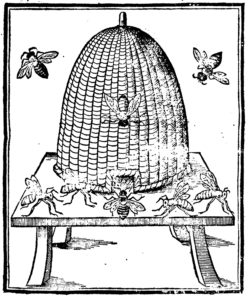After arriving on the Skellig, the monks had to create a dwelling that was both functional and spiritual.
[featured-image single_newwindow=”false”]
Over the centuries, they built a style of buildings that can be found in many places in Ireland, the “beehive” hut, which is also known as a “clochán.” The huts were built with the local rocks available to them and were created to shield the monks from the harsh weather atop the rock.
Archeological evidence has identified the remains of six beehive cells. The cells typically housed 2-3 monks at a time and were mainly used as sleeping quarters. One may have also been used as a library and another as a “refectory.” It is believed that no more than 12-13 monks lived on the island at one time.
The cells were designed with a distinct architecture that resembles an ancient artificial beehive called a skep, which was essentially a domed woven basket that was kept over the bees.

Bees were revered both in pagan cultures as well as in Christianity. They were seen as symbols of wisdom and the bees’ ordered life in the hive provided ample meditation for the monastic monks.
Bees collect nectar from a flower and then return back to the hive to transform it into honey. It is analogous to someone who listens to the word of God, retreats to their “inner room” and meditates on it, savoring its sweetness. This is described in the book of Revelation when St. John writes, “So I went to the angel and told him to give me the little scroll; and he said to me, ‘Take it and eat; it will be bitter to your stomach, but sweet as honey in your mouth’” (Revelation 10:9).
Saint Francis de Sales uses this activity of bees in a different analogy, relating it to the sacrifice of the Mass, “When the bee has gathered the dew of heaven and the earth’s sweetest nectar from the flowers, it turns it into honey, then hastens to its hive. In the same way, the priest, having taken from the altar the Son of God (who is as the dew from heaven, and true son of Mary, flower of our humanity), gives him to you as delicious food.”
Saint John Chrysostom, a saint the monks would have been familiar with, wrote, “The bee is more honored than other animals, not because it labors, but because it labors for others.”
Beekeeping was very common in Ireland at that time and was an essential part of monastery life. Beeswax candles were used in the many liturgical ceremonies of the monks and were always in high demand.
While the monks on Skellig Michael weren’t able to maintain a hive of bees on their small island, they would have been familiar with beekeeping before leaving a monastery on the mainland to embrace their call to the desert life of the Skellig.

